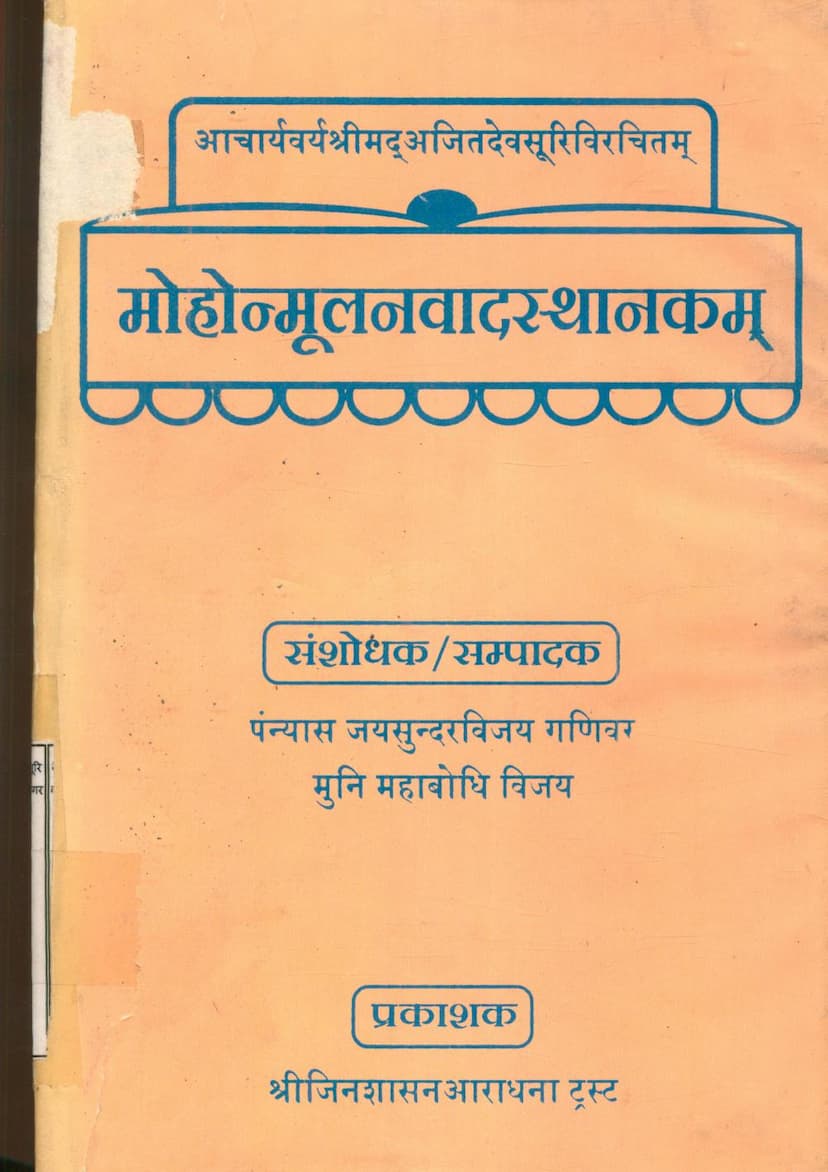Mohonmulanvadsthanakam
Added to library: September 2, 2025

Summary
This document is a Jain text titled Mohonmulanvadsthanakam (मोहोन्मूलनवादस्थानकम्), authored by Acharya Ajitdev Suri (आचार्यवर्य श्रीमद् अजितदेवसूरिविरचितम्). The text was researched and edited by Nyas Jayasundarvijay Ganivar Muni Mahabodhi Vijay (पंन्यास जयसुन्दरविजय गणिवर मुनि महाबोधि विजय) and published by Shree Jinshasan Aradhana Trust (श्रीजिनशासन आराधना ट्रस्ट).
The book contains two "Vadsthanakas" (वादस्थानकम्), which are theological or philosophical debates or dissertations:
-
Mohonmulanvadsthanakam (मोहोन्मूलनवादस्थानकम्):
- Main Topic: The central theme of this section is the debate regarding the right to perform Jina-bimba Pratishtha (प्रतिष्ठा - the consecration of Jina images). The core question is whether a Sadhu (साधु - monk/ascetic, specifically an Acharya) can perform Pratishtha or if it is exclusively the domain of a Shravaka (श्रावक - lay follower).
- Historical Context: This dispute was significant around the 12th century Vikram Samvat. The text mentions that at one point, the prominent Acharya Hemachandra Suri even considered accepting the view that Pratishtha could only be performed by laypeople, provided that their own performed Pratishthas were recognized.
- Author's Stance: Acharya Ajitdev Suri, using the authority of various ancient Jain scriptures, strongly establishes the position that Sadhus can indeed perform Pratishtha. He also provides powerful rebuttals to the arguments of those who believed only laypeople could perform it.
- Arguments of the Opposing Side: The opposing side cited scriptures like Tilakamanjari, Kathakosh, Panchashak, Upamiti, and Prashamrati to support their claim that only Shravakas should perform Pratishtha.
- Arguments of the Author's Side: In response, Acharya Ajitdev Suri refutes these claims, citing scriptures like Pratishthakalpa and Panchashak to establish the validity of Pratishtha performed by Sadhus.
- Specific Discussions:
- The author addresses the accusation that Sadhus involved in Pratishtha might be violating their vows. He argues that the accusation is misplaced and would be more fitting for those who undertake the immense task of building temples.
- He clarifies issues related to the use of wealth in Pratishtha, particularly concerning whether Acharyas might incur fault for using devotional wealth (Devdravya) in specific circumstances. He explains that when an image is not yet consecrated (i.e., has no divine presence), using such wealth is not considered fault-worthy of "Devdravya bhog."
- He also explains how any minor use of wealth by Sadhus in Pratishtha is justified according to scriptural principles.
- He mentions historical instances of Pratishthas performed by ancient Acharyas in various regions like Shrimaal, Malwa, Marwar, Mewar, Karnataka, and Lata, citing inscriptions from places like Bhinmal and Sanchor. He specifically references Pratishtha inscriptions by Acharya Kalikacharya in Kashahadanagar and Acharya Vajraswami's disciple Vansen Suri in Sopara.
- The author asserts that the Pratishtha of images should be performed by Acharyas and supports this with extensive logical reasoning.
- He laments that despite the consensus of five respected scholars (Gitasrthas) on the matter, some people still reject the view of Acharya-performed Pratishtha, attributing this rejection to their intellect being clouded by delusion. He stresses the importance of adhering to the consensus of such learned individuals.
- The author refutes the idea that if even one or two scholars disagree with a practice, it becomes invalid, citing similar situations in other religious practices.
- He discusses the distribution of wealth during Pratishtha and provides clarity on who is considered the primary performer of Pratishtha (starting with the architect, then lay followers, and then monks).
- The text was composed in Vikram Samvat 1185.
-
'Shwetapatata Kriyate Maya' Vakyarth Vichar Vadsthanakam ('श्वेतपटता क्रियते मया' वाक्यार्थविचारवादस्थानकम्):
- Main Topic: This section is a linguistic and philosophical analysis of the Sanskrit phrase "Shwetapatata Kriyate Maya" (श्वेतपटता क्रियते मया), meaning "Whiteness is made by me."
- Core Argument: The debate centers on the grammatical correctness and philosophical implication of the word "Shwetapatata" (श्वेतपटता). The author meticulously examines various compound possibilities (Samas) for "Shwetapat" (श्वेतपट) and delves into the nature of "Tad-pratyaya" (ता - the suffix meaning abstract quality or state).
- Linguistic Analysis:
- The text explores nine potential grammatical compounds for "Shwetapat."
- It then proceeds to analyze the abstract suffix "ta" (ता), discussing thirty different perspectives on how "commonality" (सामान्य) might be understood in this context.
- The author also discusses the grammatical mood "Kriyate" (क्रियते) in the passive voice, suggesting that the concept of "action" or "karma" doesn't fit well with "Shwetapatata."
- Philosophical Depth: The analysis highlights the profound scholarship of Acharya Ajitdev Suri, showcasing his deep understanding of grammar, logic, and philosophy.
- Dating: While no specific date is given for this section, it is presumed to have been composed around the same time as the first section (around Vikram Samvat 1185).
Overall Significance:
- The book is a significant contribution to Jain philosophy and literature, particularly concerning the ritual of Pratishtha.
- It demonstrates the author's mastery of scriptural interpretation and logical argumentation.
- The second section showcases a rare and detailed linguistic analysis, highlighting the intellectual rigor of Jain scholarly traditions.
- The publication is presented as an effort to preserve and disseminate ancient Jain knowledge, which has been affected by the passage of time.
- The "Prakashakiya Nivedan" (प्रकाशकीय निवेदन - Publisher's Note) emphasizes the importance of preserving the vast Jain scriptural heritage (Shrut Nidhi) in challenging times and thanks various individuals and organizations for their support in this endeavor.
The text is a scholarly work intended for serious study by those interested in Jainism.